ZEN MESTEREK ZEN MASTERS
« Zen főoldal
« vissza a Terebess Online nyitólapjára
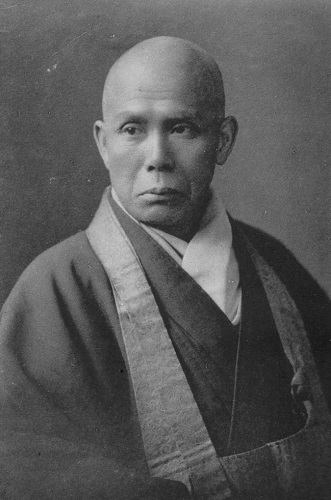
Soyen Shaku (1860-1919)
釋宗演・釈宗演 Shaku Sōen; 洪嶽宗演・洪岳宗演 Kōgaku Sōen; 楞伽窟 Ryōgakutsu
Kōgaku Sōen 洪嶽宗演・洪岳宗演 (1860–1919) was known during his lifetime as Shaku Sōen 釋宗演・釈宗演 and his "chamber name" as a teacher (rōshi) was Ryōgakutsu 楞伽窟. He was a disciple of 今北洪川 Imakita Kōsen (1816-1892). He gained notoriety not only as a teacher in the Rinzai denomination of Zen and abbot of the Engakuji monastery, but through his role of chief of the Japanese delegation in the 1893 World's Parliament of Religions in Chicago. Subsequently, Suzuki Daisetsu Teitarō 鈴木大拙貞太郎 (1870–1966), one his disciples, lived in the United States and worked with Paul Carus (1852–1919) at the Open Court Publishing Company. Part of the correspondance between Sōen and Carus subsists.
http://en.wikipedia.org/wiki/Soyen_Shaku
http://evols.library.manoa.hawaii.edu/handle/10524/33746
Sōen was head priest of the Tōkeiji from 1905 until his
death in 1919, when he was given the title of Restoring
Founder of the Temple (chūkō kaizan). Matsu-ga-oka
Bunko, the library of his distinguished disciple, Suzuki
Daisetz (1870-1966) is located at the top of a stone stair-
way behind the temple.
Sōen was followed by his disciple Satō Zenchū (1883-
1935), the abbot in residence during the Great Earthquake
of 1923. After his death the Tōkeiji was administered for
six years by Asahina Sōgen (1891-1979), abbot of the
Jōchiji, and after 1941,head of the Engakuji. Zenchū's
disciple, Inoue Zenjō (1911-2006), who pursued his studies
and Zen training during this time, became resident abbot
of the Tōkeiji in 1941.Sanctuary: Kamakura's Tokeiji Convent
by Sachiko Kaneko Morrell & Robert E. Morrell
Japanese Journal of Religious Studies 10/2-3 1983, p. 224.
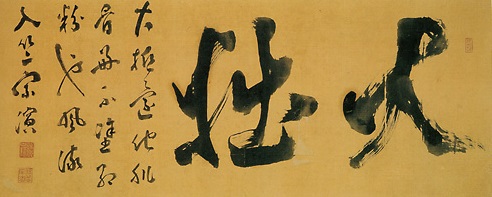
大拙 Dai-setsu by Kōgaku Sōen
Suzuki received his religious name "Daisetz" (Great Simplicity) from Kōgaku Sōen (Sōen Shaku) (1859-1919), abbot of Engaku-ji Temple. The precise date Suzuki received this name is unknown. However, Sōen wrote in December 1894, "Mr. Suzuki Daisetz, my disciple," indicating that the scroll had likely been written before this date. This panel was written by Sōen.
Shaku's Dharma Lineage
[…]白隱慧鶴 Hakuin Ekaku (1686-1769)
峨山慈棹 Gasan Jitō (1727-1797)
隱山惟琰 Inzan Ien (1751-1814)
太元孜元 Taigen Shigen (1768-1837)
儀山善來 Gisan Zenrai (1802-1878)
洪川宗温 Kōsen Sōon (1816-1892) [今北 Imakita]
洪岳宗演 Kōgaku Sōen (1859-1919) [釋 / 釈 Shaku]
For further information about Sōen, see:
Auerback, Micah. 2012. A Closer Look at Zen at War: The Battlefield Chaplaincy of Shaku Soen in the Russo-Japanese War (1904–1905). In Buddhism and Violence: Militarism and Buddhism in Modern Asia, edited by Vladimir Tikhonov, and Torkel Brekke. New York: Routledge, pp. 152–171.
PDF: The Use of Traps and Snares: Shaku Sōen Revisited by Michel Mohr
In: Zen Masters, edited by Steven Heine, and Dale Stuart Wright. New York: 2010, pp. 183–216.
PDF: Sermons of a Buddhist Abbot [Zen For Americans]
addresses on religious subjects by the Rt. Rev. Soyen Shaku, lord abbot of Engaku-ji and Kencho-ji, Kamakura, Japan,
including the sutra of forty-two chapters;
translated from the Japanese by Daisetz Teitaro Suzuki.
Chicago, The Open Court Publishing Company; [1906]
http://sacred-texts.com/bud/zfa/index.htm
PDF: Eloquent Silence
Nyogen Senzaki's Gateless Gate and Other Previously Unpublished Teachings and Letters
edited and introduced by Roko Sherry Chayat; foreword by Eido Shimano
Wisdom Publications, 2008, 456 pages
Part VI: The Autobiography of Soyen Shaku
(Translated and with Comments by Nyogen Senzaki) 347Part VII: Correspondence 363
To Soyen Shaku, December 25, 189? 365
To Soyen Shaku, March 21, 1905 378
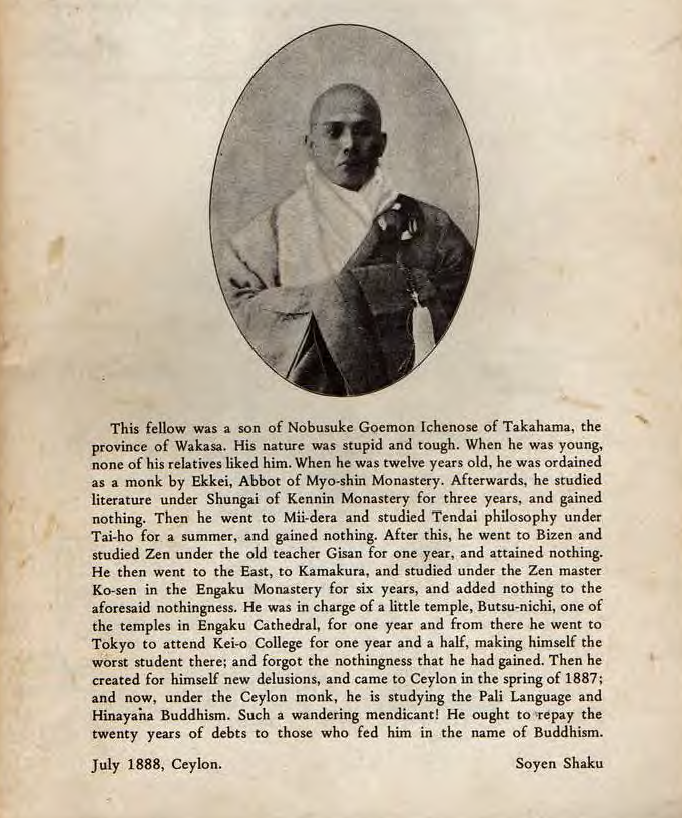
Cover page of Wind Bell, Fall 1969, Vol. VIII, Nos. 1-2.
ON SOYEN SHAKU ROSHI (1859-1919)
by Shigetsu Sasaki Roshi (1882-1945)
Wind Bell, Fall 1969, Vol. VIII, Nos. 1-2. pp. 7-9.
Soyen Shaku was a unique figure among the Buddhist priests of his day.
Certainly he was not one of those who merely followed the traditional
attitudes. He was a graduate of Keio Gijiku, now Keio University, which had
been established by Ukichi Fukuzawa, on his return from America in 1866,
as a school for the study of western culture and learning. Soyen had been sent
to Keio Gijiku by his teacher Kosen, who seems early to have recognized the
genius of his disciple and to have foreseen the influence he was destined to
wield in the world of modern Zen. So during the early years of Meiji, while
other Buddhists were sleeping comfortably pillowed on the customs of the
feudal period, Soyen was studying western thought and culture. Later, in
1887, when he was twenty-nine years old, he was sent to India to complete
his education with the study of Sanskrit. Here we must not forget that his
teacher Kosen was also an unusual man in that he chose for his disciple an
education which was both modern and ancient.
In 1893, the year following the death of his teacher, Kosen, Soyen
was invited to attend the World's Parliament of Religions to be held
at the Columbian Exposition in Chicago. Despite the opposition of his
associates and followers, both monks and laymen, he accepted the invitation.
Gary Snyder: They said it was beneath the dignity of a Zen priest to go
to a barbarian country.
He was the first Zenshu priest to come to America.
Nyogen Senzaki: After his return home from America, he stayed in
Kamakura for about ten years, teaching Zen students. During that period, I
went to Kamakura and studied Zen under his guidance. D. T. Suzuki was my
senior student. Even though he was a layman at the time, as now, we monks
resputed him for his eagerness of learning both in Zen and worldly knowledge.
Eight years later Mr. and Mrs. Alexander Russell of San Francisco knocked
at the door of Engaku-ji and entreated Soyen to instruct them in the principles
of Zen. In the urly summer of the same year, 1905. Soyen returned to
America as their guest and remained with chem until the following spring.
Eido Tai Shimano: Soyen Shaku stayed from June 27, 1905 until March 12,
1906. Dr. Suzuki was already in Chicago and came to meet him on July 14th,
and acted as his interpreter. Nyogen Senzaki arrived in San Francisco from
Seattle on July 29th and stayed at Mrs. Russell's until August 8th, then left
because he could not stay as a guest and had to perform manual labor, but
was not used to it and nor in perfect health.Nyogen Senzaki:
This Sister in Dhamma (Mrs. Russell) passed a few years after my teacher went back
to Japan, but we must remember her as the gate-opener of Zen in America. She
was the first American who experienced the actual study of Zen koans.
I was left in Ameriica to do something for Buddhism, but as you all know,
my work is very slow and I have neirher an agressive spirit of propaganda
nor an attractive personality to draw crowds. If my teacher were still living,
he would have been disappointed in me. Among many disciples he found
two monks who wished to work in foreign countries. One was So-ko Uyemura,
and the other was myself So-ko Uyemura had to go to war and lost his life,
so, America had to pick up this monk- a poorer one. I am very sorry about it.
Afterwards he (Soyen Roshi) visited many American cities and then continued
his journey homeward by way of Europe and India.
It was on his final home-turning that Soyen manifested his true ascetic
nature. Living in magnificent temples and wearing gorgeous robes offered by
lay adherents is really contrary to the commandment for monks. They make
this concession only as a necessary expedient (upaya) for the promulgation
of the Dharma. When he visited the sacred land of Buddha Soyen went as a
simple pilgrim. Though his funds were exhausted he did not notify his temple.
He did not call upon his government to assist him in his need, though that
would have been very easy for him to do as the Patriarch of a wealthy and
famous temple. It was as a simple Buddhist monk that he went through India,
begging his food from door to door, with pious faith in the Buddha and with
humble acquiescence in the ancient rules of the Sangha.
Alone he boarded a native coastal steamer sailing for Shanghai, one bowl
in his hand and one kesa on his body. Among his fellow steerage passengers
was a beggar who accosted him. Soyen pitied him and gave him the kesa, the
last shred hanging from his shoulders. On the tropical sea, under the tropical
sky, he spent many nights on the deck sitting in profound meditation. Dawn
found the hungry mosquitoes he had fed hanging from his naked body like
ripe red berries.
When he reached Shanghai monks from Engaku Temple were waiting
on the wharf, bearing his robes and his rosary. For the first time the
Japanese cabin-passengers realized that this deck-passenger was nor only their
countryman but also the famous Soyen.
Nyogen Senzaki: In his late years, our Roshi held his position as the
Superintendent, both of the Engaku and Kancho branches of the Rinzai
sect. At the same time he was president of Rinzai College for some years. He
was very busy giving lectures in many parts of japan, Korea, and China. ...
My teacher wrote forty books in Japanese and Chinese. He had about ten
successors and hundreds of monk disciples-- and also thousands of laymen
and lay women adherents. He has been gone from us thirty years, still, we
all consider him living with us as long as we keep our Zen.
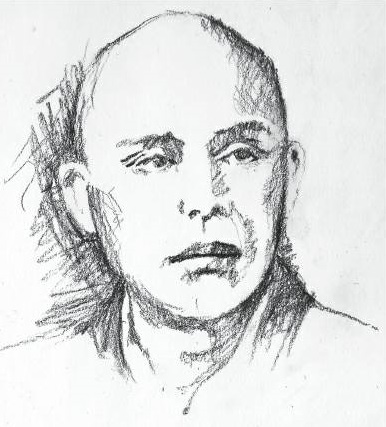
Portrait of Soyen Shaku by Molly Macnaughton
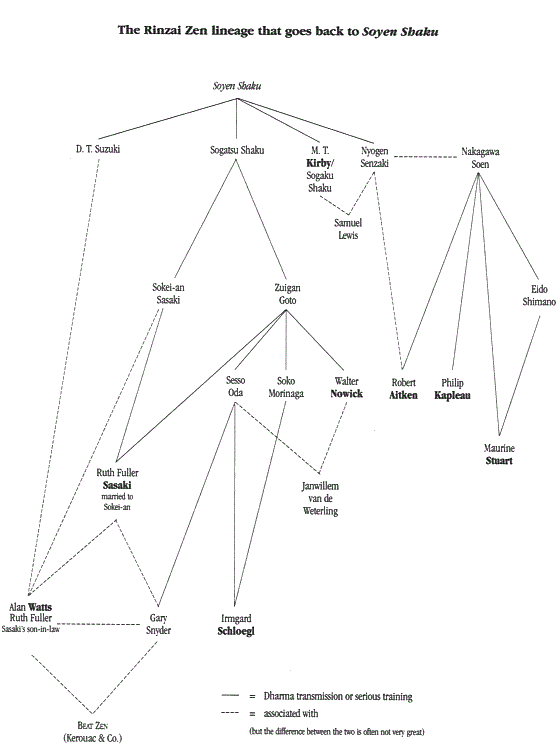
SOYEN SHAKU
Richard Bryan McDaniel: Zen Masters of Japan. The Second Step East. Rutland, Vermont: Tuttle Publishing, 2013.
There are two “stories” about Soyen Shaku in Senzaki’s book, although one is not a narrative but rather a list of rules that Soyen developed for himself and to which he adhered throughout his life:
In the morning before dressing, light incense and meditate.
Retire at a regular hour. Partake of food at regular intervals. Eat with moderation and never to the point of satisfaction.
Receive a guest with the same attitude you have when alone. When alone, maintain the same attitude you have in receiving guests.
Watch what you say, and whatever you say, practice it.
When an opportunity comes do not let it pass by, yet always think twice before acting.
Do not regret the past. Look to the future.
Have the fearless attitude of a hero and the loving heart of a child.
Upon retiring, sleep as if you had entered your last sleep. Upon awakening, leave your bed behind you instantly as if you had cast away a pair of old shoes. (62)
Soyen Shaku was born Tsunejiro Ichinose in 1859. He was sent to a local temple school where, in an autobiographical statement he wrote later, he was taught to respect the Three Treasures (Buddha, Dharma, and Sangha) as well as to be “filial to my parents and helpful to my brother and sisters, to be loyal to my country and faithful to my compatriots.” (63)
His older brother, Chutaro, felt drawn to monastic life, but family responsibilities after the death of their father prevented him from doing so. Tsunejiro decided to take the precepts in his brother’s stead and became a monk at the age of twelve. He was originally given the Buddhist name Soko. However, because another monk had the same name, their teacher invited Tsunejiro to choose his own name. He elected Soyen in honor of a younger monk of that name who had died.
He studied with two prior masters before he came to work with Kosen at Engakuji, and under their direction was formally introduced to zazen. He was so committed to the practice that during one Rohatsu Sesshin (the December retreat marking the anniversary of the Buddha’s enlightenment), he sat outside for two days so wholly absorbed in meditation that he failed to notice when he became covered with snow. Soyen received inka from Kosen at the age of 25. At that time, Kosen is said to have remarked that his young disciple was a “born bodhisattva.”
Although Kosen fought the restrictions initially placed upon Buddhism by the Meiji regime, he came to be a supporter of the government’s policies and even accepted an appointment to serve as an Instructor for the Ministry of Doctrine. He shared the government’s belief that it was essential for Japan to adopt those western institutions that could best assist in its modernization. So after Soyen completed his Zen training, rather than having him go on the traditional pilgrimage to Zen temples in the country, Kosen encouraged him to enroll in the new Keio University.
Soyen stayed there for three years, after which he made use of the greater freedom the Japanese now had to travel outside their country to visit Ceylon (now Sri Lanka). His goal was to deepen his understanding of Buddhism by familiarizing himself with the older Theravada tradition, but the young Japanese found conditions in the island nation extremely difficult. He wrote back to Kosen that the only thing in Ceylon that seemed the same as at home was the barking of the dogs. In particular, he was unprepared for the tropical heat which was so severe he was unable to take part in the traditional begging rounds with the other monks.
He admired the life-style of the Ceylonese monks—bhikkus—and their commitment to the precepts; however, he was never able to communicate with them very well, and he realized that they would be bewildered if he attempted to explain Zen with its emphasis on personal enlightenment.
In a talk given to his American students in 1947, Nyogen Senzaki told this story about Soyen’s return trip to Japan after spending three years in Ceylon. He went from Singapore to Thailand on a steamship. He had almost no money and could only afford to travel as a deck passenger. He was still unused to the tropical heat, and the glare of the sun on the open deck of the ship was a misery. There was little water, and he had no food. Then, to make his situation even worse, the ship had to anchor on the coast at the mouth of a river in order to wait for the turn of the tide. The deck passengers were immediately attacked by hordes of mosquitoes. As evening approached, dark clouds appeared in the distance that only made the humidity more oppressive, and he could get no rest because of the heat and the voracious pests. Finally, he found a small area on the deck that provided him a little privacy. There he removed most of his clothing and formed it into a cushion to sit upon, then tried to enter meditation—allowing the mosquitoes to feed as much as they liked on his bare skin. For a long while the drone of the feeding insects prevented him from entering into the state of samadhi, but eventually he succeeded and his mind became fully concentrated. He was no longer aware of the mosquitoes, the heat, or his thirst. When a rainstorm roused him from his meditation, he heard in the distance a temple bell ringing, and he smiled in contentment. Looking about he saw that a number of bright red wild berries of some kind had fallen about him. Examining them more closely, he discovered they were not berries at all, but mosquitoes so engorged with his blood that they were unable to fly.
A year after Soyen returned to Japan, Kosen died, and his young disciple was appointed principal teacher at Engakuji.
As had Kosen, Soyen supported the policies of the Meiji government, including their military excursions into China and Russia. During the Russo-Japanese War [1904-05], he took time from his duties at Engakuji to serve as a chaplain in the First Army Division and would later argue that the Japanese victory was due, in part, to the strength the nation drew from Buddhist culture and specifically from Zen training which aided in instilling a “samurai spirit” in the population. It was a point of view in which many people in the higher levels of government began to see some validity. By the end of the Russo-Japanese War, Zen practice was no longer considered suspect.
The Meiji Era came to an end with the death of the Emperor in 1912. The period lasted less than forty-five years, a relatively short time in history. However the changes that were wrought in Japan during those years were brisk and effective. By the end of the Meiji Era, Japan was recognized as a world power on a par with the United States and the more developed nations of Europe. Japan was now a major player on the global stage, and the scene was set for Zen to move beyond the confines of Asia.
Epilogue in Chicago
By the end of the 19th Century, Asian studies had not only acquired a degree of respectability in the West, they had also attracted a popular interest that would not have been imaginable only a few decades earlier. But then the post-Darwinian world was a place of rapid change.
While Christian doctrine was under attack from scientific rationalism, a group of scholars and translators wondered if non-theistic Buddhism—especially as expressed in the Theravada tradition—might not provide the basis for a faith system better suited to bridge the growing rift between science and religion. In popular culture, charlatans like the Russian-born founder of Theosophy—Helena Petrovna Blavatsky—made claims about the mysterious doctrines of the East that found willing adherents among the gullible and desperate.
Liberal Christians sought for a means of regaining lost ground and establishing a rapprochement with the scientific community. They chose the Chicago World’s Fair of 1893 as their venue. Also known as the Columbian Exposition, the Fair marked the 400th anniversary of Columbus’s first voyage to the Americas and was touted to be a celebration of Western technological achievement. A World Parliament of Religions was proposed which would take place at the same time. It was to be a gathering of representatives from the major religious traditions of the globe. The organizers hoped to be able to identify principles shared by all faiths and then, no doubt, to demonstrate that Christianity provided the most fully evolved exposition of those principles.
Among those invited to participate in the Parliament was the Japanese Zen Abbot, Soyen Shaku. Some of his colleagues advised him to refuse the invitation on the grounds that the barbarians of the United States would not be able to understand or appreciate the Buddha Dharma; however, after giving the invitation careful consideration, Soyen decided to take part. He composed a paper on the Buddhist teachings regarding cause and effect, and, because he did not know English, he asked one his students to translate it into that language for him. The student was Teitaro Suzuki, whose Buddhist name—Daisetsu—meant “Great Humility.”
Soyen was in Chicago for the presentation of his paper, which was read on his behalf by one of the Parliament’s organizers. In the audience at the time was a German Orientalist resident in nearby LaSalle, Illinois, Paul Carus. Carus approached Soyen and asked if he would consider assisting him in a project to make translations of Buddhist writings available in the West. Soyen demurred, explaining that he was not qualified to do so nor could he take further time from his duties at Engakuji. He did, however, suggest that the young student who had translated his paper into English might be up to the task.
So it was that D. T. Suzuki came to Illinois in 1897, and—with him—Zen took its third step east, across the Pacific Ocean, to the Americas.
Sōen, Kōgaku (Shaku)
Seinan no bukkyō 西南之佛敎
64 scanned pages
http://evols.library.manoa.hawaii.edu/handle/10524/33763
This publication constitutes Sōen's account of his journey to Ceylon (Sri Lanka) and Thailand from March 8, 1887 to October 12, 1889. It was sent to Japan and published in January 1889, before his return. It contains drawings, as well as prefatory remarks in Sinhalese from Dharmapala, his teacher in Ceylon. The two forewords were written by Sōen's teacher in Japan, Kōsen Sōon 洪川宗温 (Imakita 今北 1816–1892), and by his sponsor, Tokuan Torio Koyata 得庵 鳥尾小彌太 (1847–1905).
The title of this publication "Buddhism in the South-west" illustrates how Ceylon was viewed from the Japanese perspective, as opposed to the Eurocentric perspective that would describe it as "South-east Asia."For further information about this publication, see Jaffe, Richard M. 2004. Seeking Śākyamuni: Travel and the Reconstruction of Japanese Buddhism. Journal of Japanese Studies 30 (1): 65–96.
Sōen_1889_Seinan_no_bukkyō.pdf
134.2Mb
Seven Daruma paintings by Sōen, Kōgaku (Shaku)
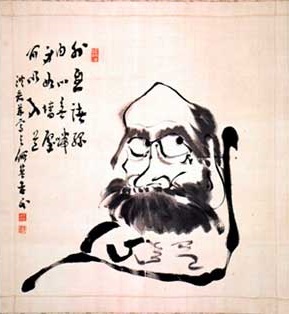
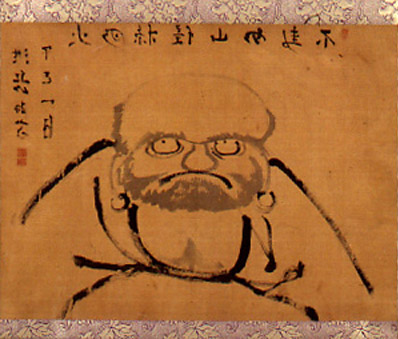
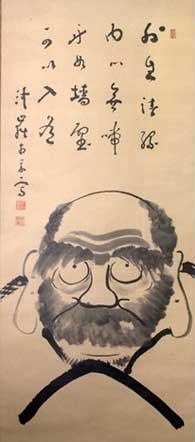
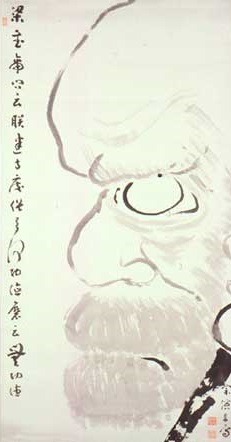
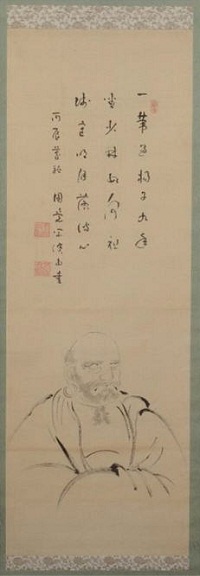
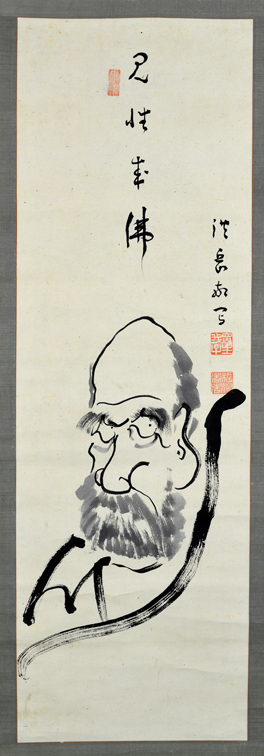
Painting of Bodhidharma. 95 × 30.6 cm
You see your true nature-become Buddha. Painted by Kogaku respectfully.

Painting of Bodhidharma.
134.5 × 33.5 cm
Very open and boundless like the sky. Bodhidharma's mind cannot be known.
He made every effort to save all sentient beings from suffering before he attained Nirvana.
Painted by Rokusho Kogaku.
PDF: Particular and Universal: Problems posed by Shaku Soen’s “Zen”
by John M. Thompson
2005